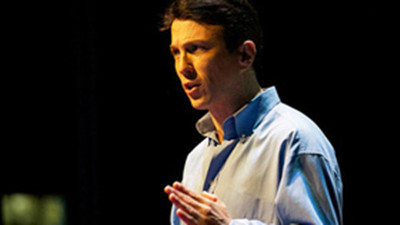A couple of years ago when I was attending the TED Conference in Long Beach,I met Harriet.
幾年前我參加在長灘TED會議的時候,我遇到了哈里特。
We'd actually met online before not the way you're thinking.
實際上我們以前在網上遇到過,不是像你們想的那樣。
We were actually introduced because we both knew Linda Avey,one of the founders of the first online personal genomic companies.
我們認識是因為我們都認識琳達埃維,首家私營基因公司創始人之一。
And because we shared our genetic information with Linda,she could see that Harriet and I shared a very rare type of mitochondrial DNA Haplotype K1a1b1a-K1a1b1a which meant that we were distantly related.
并且因為我們和琳達分享我們的基因信息,她知道哈里特和我都有一種很稀有的線粒體DNA-單模標本-這意味著我們是遠親。
We actually share the same genealogy with Ozzie the iceman.
實際上,我們都和冰人奧茲有親緣關系。
So Ozzie, Harriet and me.
沒錯,奧茲,哈里特和我。
And being the current day, of course, we started our own Facebook group.
當然,如今我們有了自己的臉書網群組。
You're all welcome to join.
歡迎你們加入。
And when I met Harriet in person the next year at the TED Conference,she'd gone online and ordered our own happy Haplotype T-shirts.
當我在第二年TED會議遇見哈里特的時候,她在線訂購了我們自己快樂的單模標本T恤衫。
Now why am I telling you this story,and what does this have to do with the future of health?
為什么我要告訴你們這個故事,這和未來健康有什么關系呢?

Well the way I met Harriet is actually an example of how leveraging cross-disciplinary,exponentially-growing technologies is affecting our future of health and wellness,from low-cost gene analysis to the ability to do powerful bio-informatics to the connection of the Internet and social networking.
實際上,我遇見哈里特的經過是一個很好的例子關于怎樣利用學科交叉,指數增長的技術來影響我們將來的健康和保健事業,從低成本的基因分析到做強大生物信息學的能力到互聯網和社會網絡間的聯系。
What I'd like to talk about today is understanding these exponential technologies.
我今天想談的是理解這些指數增長的技術。
We often think linearly.
我們經常線性思考。
But if you think about it, if you have a lily pad and it just divided every single day two, four, eight, 16-2,4,8,16,in 15 days you have 32,000.
但是如果想像一下,如果你有一個睡蓮葉子,它每天分裂一次,15天以后會有32000個葉子。
What do you think you have in a month? We're at a billion.
你認為1個月以后有多少?我們會有10億。
So if we start to think exponentially,we can see how this is starting to affect all the technologies around us.
如果我們開始指數思考,我們會看到這會怎樣影響到我們周圍的技術。
And many of these technologies-speaking as a physician and innovator we can really start to leverage to impact the future of our own health and of health care,and to address many of the major challenges that we have in health care today,ranging from the really exponential costs to the aging population,the way we really don't use information very well today,the fragmentation of care and often the very difficult course of adoption of innovation.
許多技術-像一位物理學家和革新者所說的,我們能真正開始去利用它們,影響我們的未來健康和衛生保健,和談論如今許多衛生保健面臨的主要困難從巨額投入到高齡人群,我們沒有真正很好地使用信息的現狀,保健不均衡和常常面對困難棘手的經歷,例如采用革新的歷程。
And one of the major things we can do we've talked a bit about here today is moving the curve to the left.
今天我們談到主要的事情之一是把曲線向左移。
We spend most of our money on the last 20 percent of life.
我們在生命的最后20%時間里花費了大部分的錢。
What if we could spend and incentivize positions in the health care system and our own self to move the curve to the left and improve our health,leveraging technology as well?
如果我們能夠投資和激勵崗位在健康保健系統和我們自身來向左移動這條曲線從而改善我們的健康,利用技術,會怎么樣呢?
Now my favorite technology, example of exponential technology,we all have in our pocket.
我最喜愛的技術,指數技術的例子,在我們所有人的口袋里。
So if you think about it, these are really dramatically improving.
因此如果你想一下,你會發現這些技術真的顯著提高了。
I mean this is the iPhone 4.
我指的是iPhone 4.
Imagine what the iPhone 8 will be able to do.
想像iPhone 8將能做什么。
Now, I've gained some insight into this.
現在,我有了一些見解。
I've been the track share for the medicine portion of a new institution called Singularity University based in Silicon Valley.
我追蹤觀察新成立的奇點大學的醫學院,它座落在硅谷。
And we bring together every summer about 100 very talented students from around the world.
每個夏天我們召集世界各地100名非常有天賦的學生。
And we look at these exponential technologies from medicine, biotech,artificial intelligence, robotics, nanotechnology, space,and address how can we cross-train and leverage these to impact major unmet goals.
我們研究這些指數技術從醫學,生物技術,人工智能,機器人技術,納米技術,太空技術,來發現如何能多項培訓并利用這些技術去影響重大未實現的目標。
We also have seven-day executive programs.
我們也有一個7天執行方案。
And coming up next month is actually Future Med,a program to help cross-train and leverage technologies into medicine.
接下來幾個月的方案是未來醫學,一個幫助多項培訓和把技術應用到醫學的項目。
Now I mentioned the phone.
現在我來說電話。
These mobile phones have over 20,000 different mobile apps available to the point where there's one out of the U.K.
這些手機有超過20000個不同的應用程序,從這點上說,有一個與眾不同,
where you can pee on a little chip connected to your iPhone and check yourself for an STD.
那就是你可以通過在你的iPhone相連的一小塊芯片上小便來自查是否有性傳染病。
I don't know if I'd try that yet, but that's available.
我不知道我是否會這樣做,但是它確實可用。
There are all other sorts of applications,merging your phone and diagnostics, for example,measuring your blood glucose on your iPhone and sending that,potentially, to your physician so they can better understand and you can better understand your blood sugars as a diabetic.
還有很多種應用,把你的電話和診斷聯系在一起,例如,用你的iPhone測量你的血糖并可能把數據發給你的醫生,使得他們和你都能更好得了解,你作為一個糖尿病人的血糖。
So let's see now how exponential technologies are taking health care.
現在讓我們看看指數技術怎樣進行健康保健。
Let's start with faster.
讓我們從速度開始。
Well it's no secret that computers, through Moore's law,are speeding up faster and faster.
我們都知道,根據摩爾定律,計算機,運算速度越來越快。
We have the ability to do more powerful things with them.
因此我們能夠做更強大的事情。
They're really approaching, in many cases surpassing,the ability of the human mind.
他們正在接近,在很多情況超越,人類思維的能力。
But where I think computational speed is most applicable is in that of imaging.
但是我認為計算速度最適用的地方是在于成像技術。
The ability now to look inside the body in real time with very high resolution is really becoming incredible.
這種技術能即時的觀察身體內部用非常高的分辨率,真的很神奇。
And we're layering multiple technologies-PET scans, CT scans and molecular diagnostics to find and to seek things at different levels.
我們正在綜合多種技術--PET掃描,CT掃描和分子診斷來發現和尋找不同層面的東西。
Here you're going to see the very highest resolution MRI scan done today,reconstructed of Marc Hodosh, the curator of TEDMED.
今天在這里你們將會看到非常高分辨率的MRI掃描,它是由TEDMED的主持者馬克霍道什重建的。












